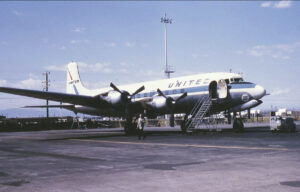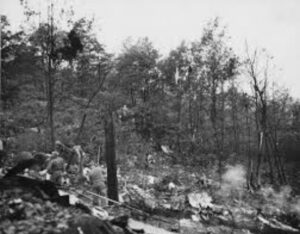 While flight remains one of the safest forms of travel, there is always the possibility of a malfunction that can have devastating effects. In the case of United Airlines Flight 624, a Douglas DC-6 airliner, registration NC37506, was a scheduled passenger flight from San Diego, California to New York City. Very likely, these passengers had taken this exact same flight a number of times, and possibly on this exact same plane. Nevertheless, this flight was about to be very different…and that difference was going to have devastating effects on the plane and on the outcome of this flight.
While flight remains one of the safest forms of travel, there is always the possibility of a malfunction that can have devastating effects. In the case of United Airlines Flight 624, a Douglas DC-6 airliner, registration NC37506, was a scheduled passenger flight from San Diego, California to New York City. Very likely, these passengers had taken this exact same flight a number of times, and possibly on this exact same plane. Nevertheless, this flight was about to be very different…and that difference was going to have devastating effects on the plane and on the outcome of this flight.
Flight 624 took off from Lindbergh Field, in what appeared to be a normal flight. The flight made its first scheduled stop at Los Angeles Airport, followed by a normal scheduled stop at Chicago Municipal Airport. Everything was normal for both stops. In fact, the  whole flight proceeded normally until they began their descent into New York’s LaGuardia Airport. They began their descent over Pennsylvania, and suddenly, they had a warning alarm telling them of a fire in the cargo hold. The crew responded to what was later determined to be a false signal of a fire in the front cargo hold by releasing CO2. Proper operating procedure called for opening the cabin pressure relief valves prior to discharging the CO2 bottles, to allow for venting of the CO2 gas buildup in the cabin and cockpit. There was no evidence found of the crew opening the relief valves. Either they forgot or it malfunctioned (which didn’t appear to be the case). As a result, the released CO2 gas seeped back into the cockpit from the front cargo hold and apparently
whole flight proceeded normally until they began their descent into New York’s LaGuardia Airport. They began their descent over Pennsylvania, and suddenly, they had a warning alarm telling them of a fire in the cargo hold. The crew responded to what was later determined to be a false signal of a fire in the front cargo hold by releasing CO2. Proper operating procedure called for opening the cabin pressure relief valves prior to discharging the CO2 bottles, to allow for venting of the CO2 gas buildup in the cabin and cockpit. There was no evidence found of the crew opening the relief valves. Either they forgot or it malfunctioned (which didn’t appear to be the case). As a result, the released CO2 gas seeped back into the cockpit from the front cargo hold and apparently  partially incapacitated the flight crew. It would be like being in a closed-up garage and leaving your car running. The decision-making process of the crew became compromised. As things got worse, the crew put the aircraft into an emergency descent, miscalculating their altitude, and as the plane descended lower than it should have, it hit a high-voltage power line and burst into flames. The plane then smashed through the trees of a wooded hillside about five miles from Mount Carmel, Pennsylvania, a small town 135 miles from Philadelphia, at 1:41pm EDT on June 17, 1948. When the four-engined, propeller-driven airplane crashed, it resulted in the deaths of all four crew members and 39 passengers on board.
partially incapacitated the flight crew. It would be like being in a closed-up garage and leaving your car running. The decision-making process of the crew became compromised. As things got worse, the crew put the aircraft into an emergency descent, miscalculating their altitude, and as the plane descended lower than it should have, it hit a high-voltage power line and burst into flames. The plane then smashed through the trees of a wooded hillside about five miles from Mount Carmel, Pennsylvania, a small town 135 miles from Philadelphia, at 1:41pm EDT on June 17, 1948. When the four-engined, propeller-driven airplane crashed, it resulted in the deaths of all four crew members and 39 passengers on board.


Leave a Reply